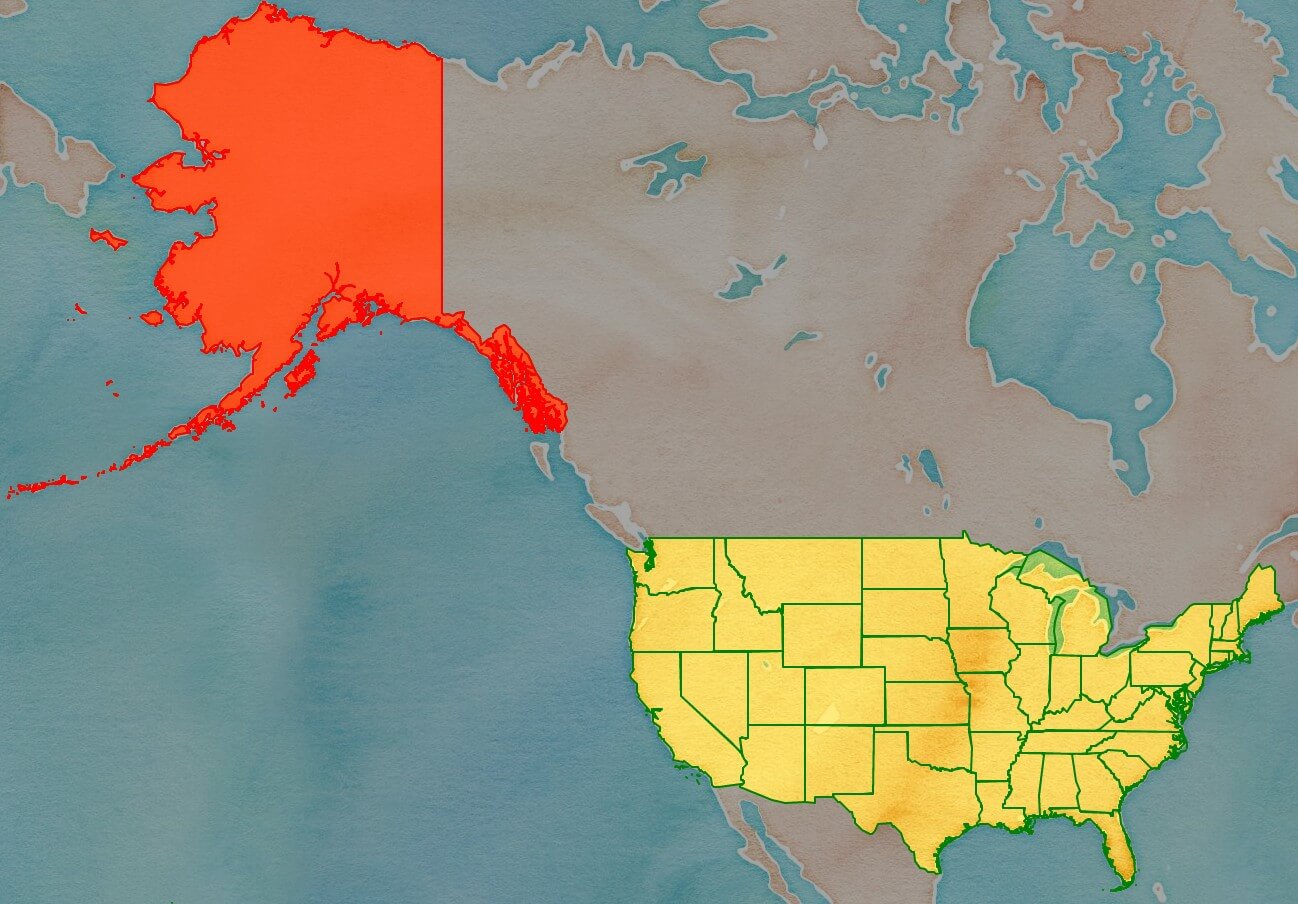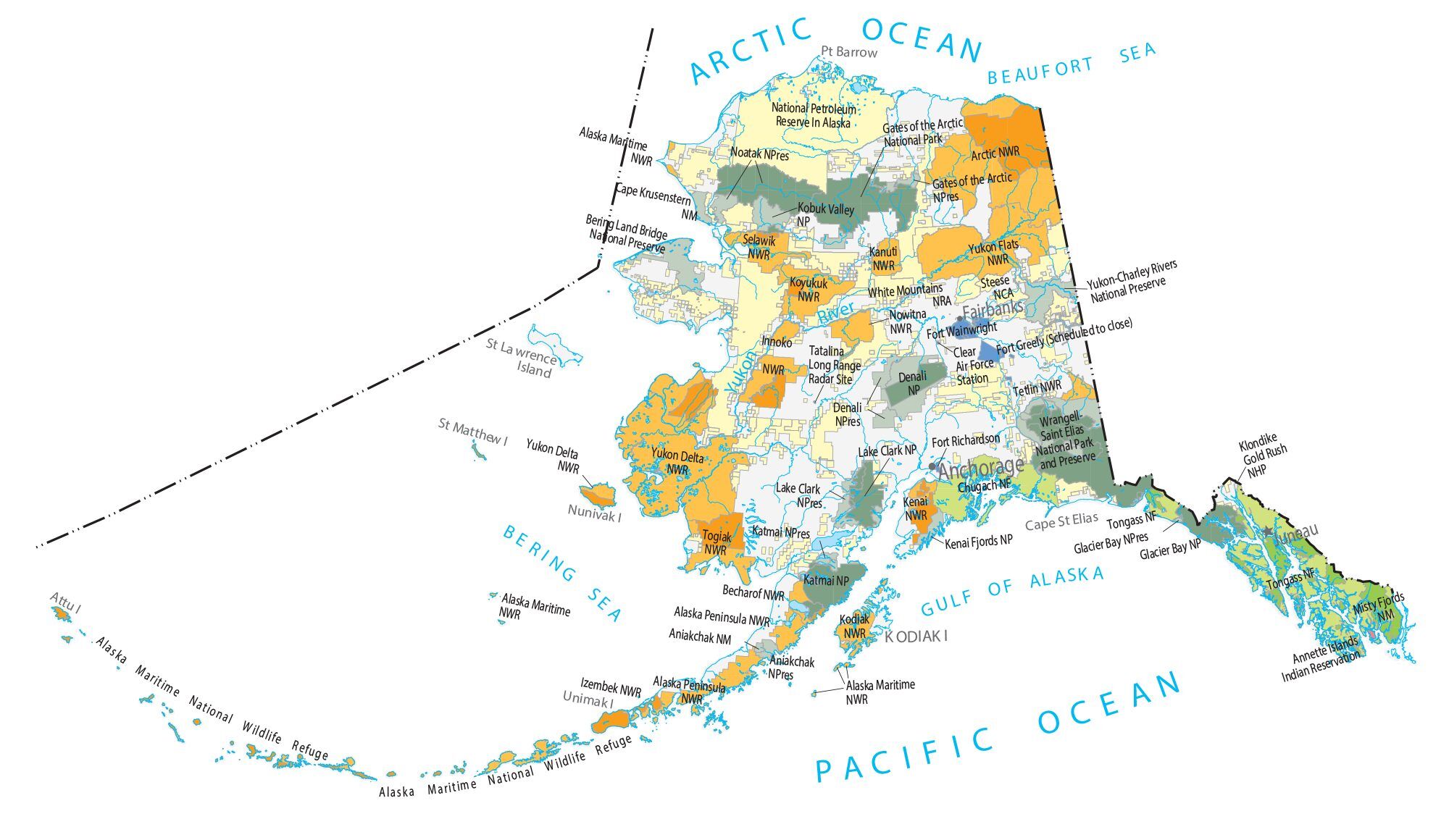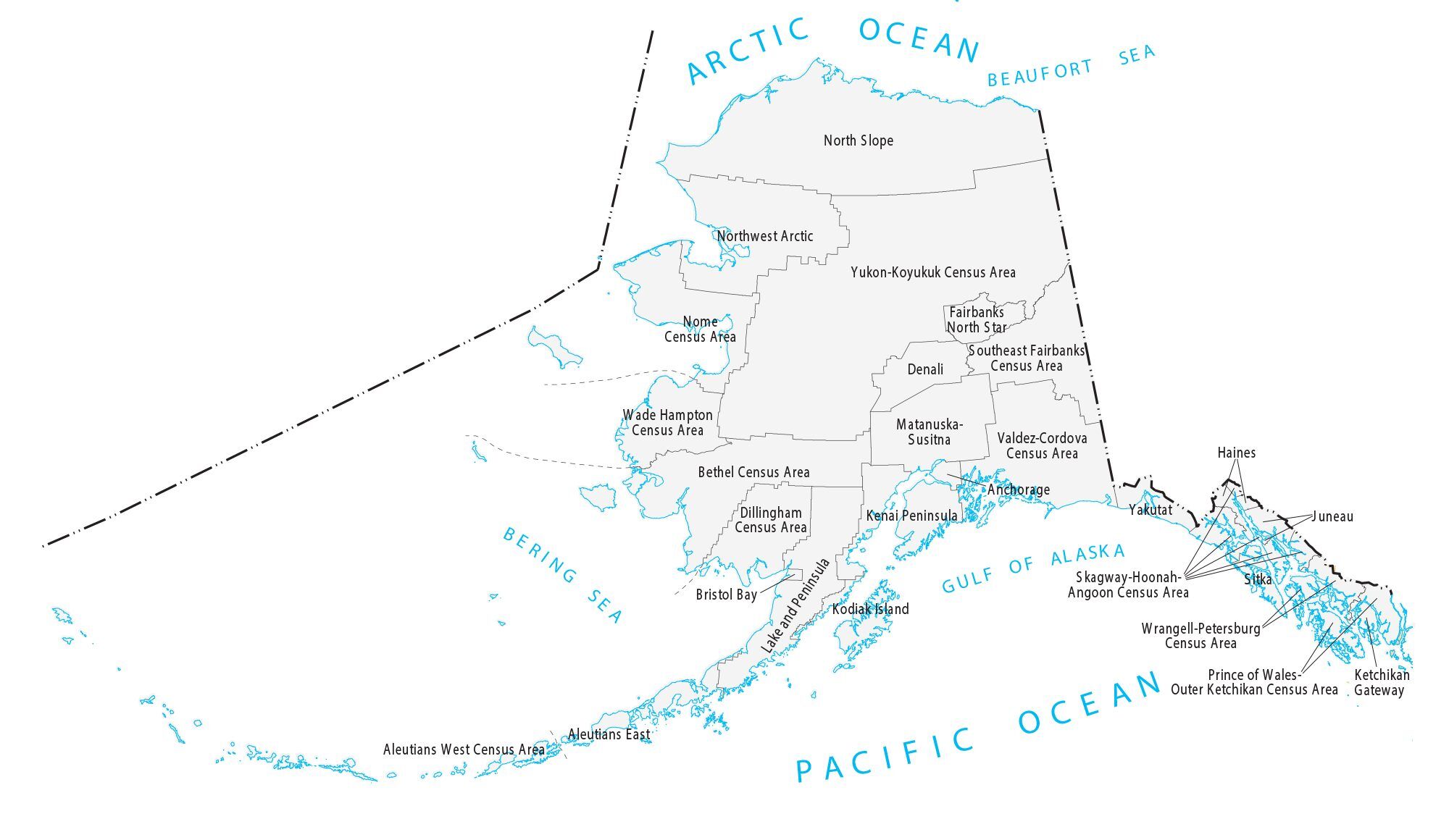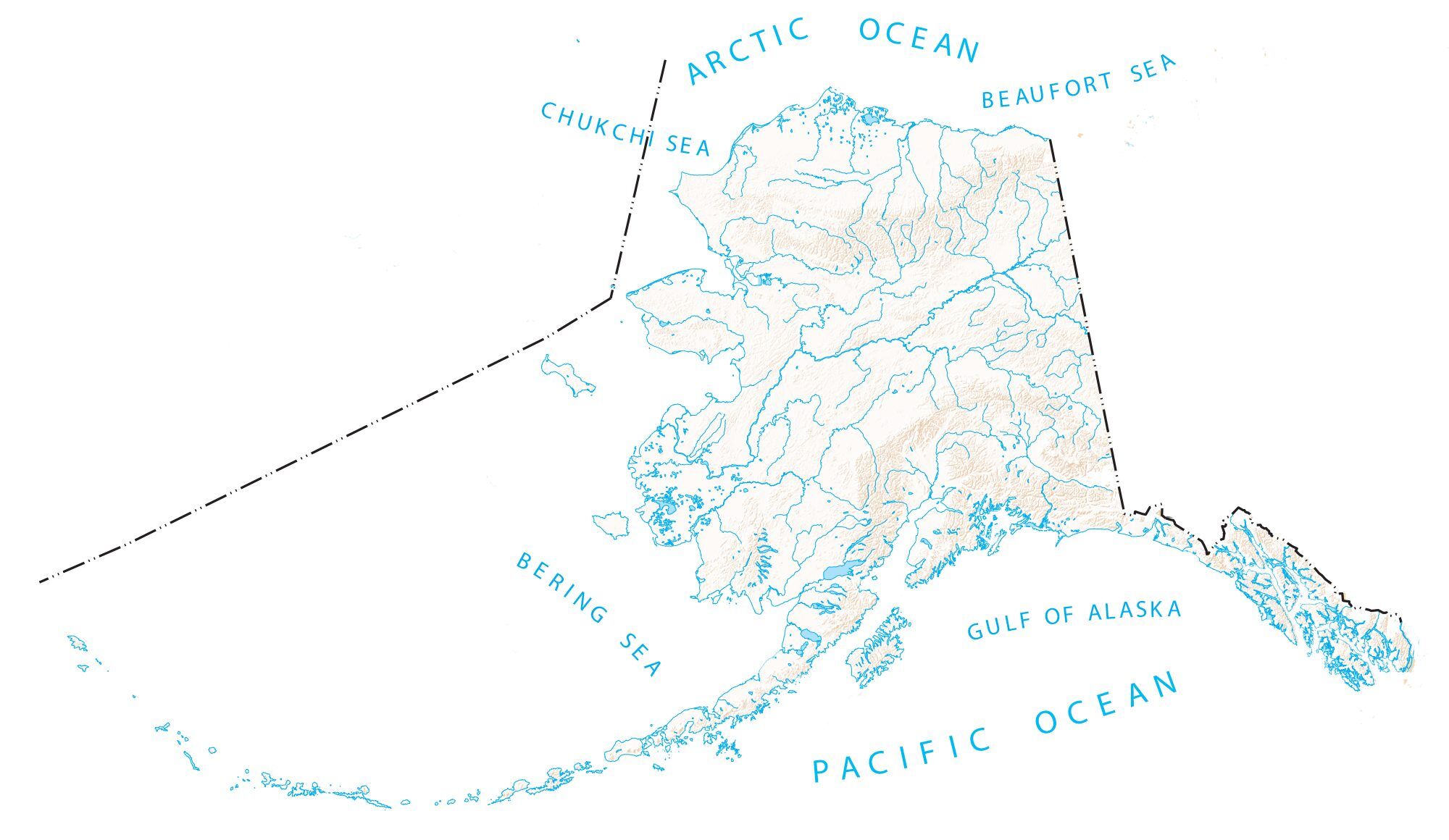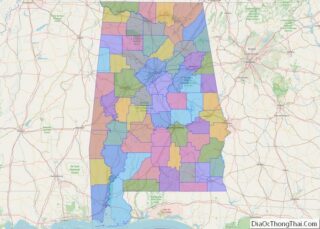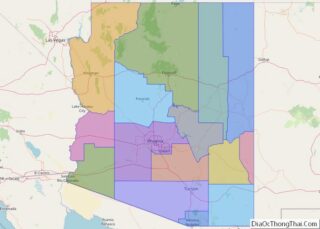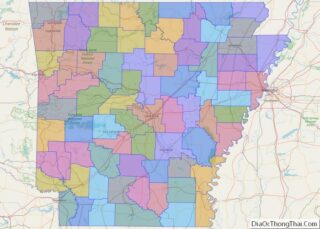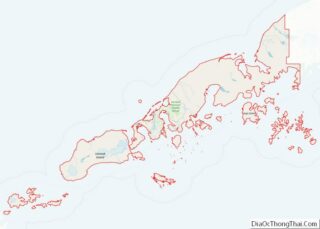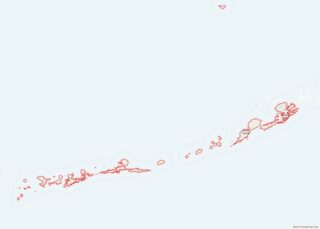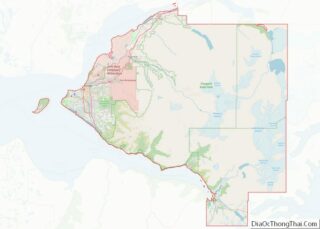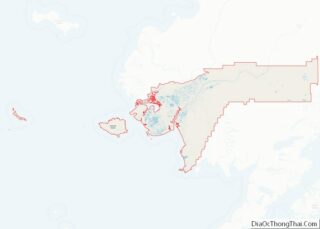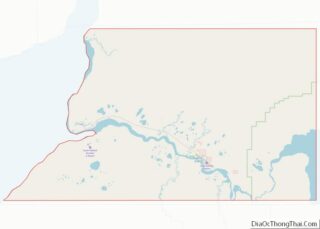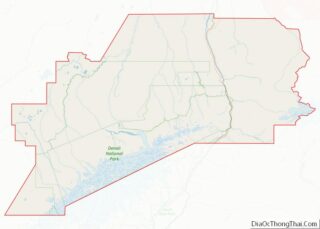Alaska (/əˈlæskə/ (listen) ə-LAS-kə) is a U.S. state on the northwest extremity of North America. A semi-exclave of the U.S., it borders British Columbia and the Yukon in Canada to the east, and it shares a western maritime border in the Bering Strait with the Russian Federation’s Chukotka Autonomous Okrug. To the north are the Chukchi and Beaufort Seas of the Arctic Ocean, and the Pacific Ocean lies to the south and southwest.
Alaska is the largest U.S. state by area, comprising more total area than the next three largest states of Texas, California, and Montana combined, and is the seventh-largest subnational division in the world. It is the third-least populous and most sparsely populated U.S. state, but with a population of 736,081 as of 2020, is the continent’s most populous territory located mostly north of the 60th parallel, more than quadruple the combined populations of Northern Canada and Greenland. The state capital of Juneau is the second-largest city in the United States by area, and the former capital of Alaska, Sitka, is the largest U.S. city by area. Approximately half of Alaska’s residents live within the Anchorage metropolitan area.
Indigenous people have lived in Alaska for thousands of years, and it is widely believed that the region served as the entry point for the initial settlement of North America by way of the Bering land bridge. The Russian Empire was the first to actively colonize the area beginning in the 18th century, eventually establishing Russian America, which spanned most of the current state, and promoted and maintained a native Alaskan Creole population. The expense and logistical difficulty of maintaining this distant possession prompted its sale to the U.S. in 1867 for US$7.2 million (equivalent to $140 million in 2021). The area went through several administrative changes before becoming organized as a territory on May 11, 1912. It was admitted as the 49th state of the U.S. on January 3, 1959.
Abundant natural resources have enabled Alaska—with one of the smallest state economies—to have one of the highest per capita incomes, with commercial fishing, and the extraction of natural gas and oil, dominating Alaska’s economy. U.S. Armed Forces bases and tourism also contribute to the economy; more than half the state is federally-owned land containing national forests, national parks, and wildlife refuges.
The Indigenous population of Alaska is proportionally the highest of any U.S. state, at over 15 percent. Various Indigenous languages are spoken, and Alaskan Natives are influential in local and state politics.
| Before statehood: | Territory of Alaska |
|---|---|
| Admitted to the Union: | January 3, 1959; 64 years ago (1959-01-03) (49th) |
| Capital: | Juneau |
| Largest city: | Anchorage |
| Largest metro and urban areas: | Anchorage |
| Elevation: | 1,900 ft (580 m) |
| Total Area: | 663,268 sq mi (1,717,856 km) |
| Area Rank: | 1st |
| Total Population: | 736,081 |
| Population Rank: | 48th |
| Population Density: | 1.26/sq mi (0.49/km) |
| Population Density Rank: | 50th |
| Median Household Income: | $77,800 |
| Income Rank: | 12th |
| Demonym(s): | Alaskan |
| USPS abbreviation: | AK |
| ISO 3166 code: | US-AK |
| Website: | alaska.gov |
Online Interactive Map
Click on ![]() to view map in "full screen" mode.
to view map in "full screen" mode.
Alaska location map. Where is Alaska state?
Alaska Road Map
Alaska Map – Roads & Cities
Alaska Street Map
History
Pre-colonization
Numerous indigenous peoples occupied Alaska for thousands of years before the arrival of European peoples to the area. Linguistic and DNA studies done here have provided evidence for the settlement of North America by way of the Bering land bridge. At the Upward Sun River site in the Tanana Valley in Alaska, remains of a six-week-old infant were found. The baby’s DNA showed that she belonged to a population that was genetically separate from other native groups present elsewhere in the New World at the end of the Pleistocene. Ben Potter, the University of Alaska Fairbanks archaeologist who unearthed the remains at the Upward Sun River site in 2013, named this new group Ancient Beringians.
The Tlingit people developed a society with a matrilineal kinship system of property inheritance and descent in what is today Southeast Alaska, along with parts of British Columbia and the Yukon. Also in Southeast were the Haida, now well known for their unique arts. The Tsimshian people came to Alaska from British Columbia in 1887, when President Grover Cleveland, and later the U.S. Congress, granted them permission to settle on Annette Island and found the town of Metlakatla. All three of these peoples, as well as other indigenous peoples of the Pacific Northwest Coast, experienced smallpox outbreaks from the late 18th through the mid-19th century, with the most devastating epidemics occurring in the 1830s and 1860s, resulting in high fatalities and social disruption.
The Aleutian Islands are still home to the Aleut people’s seafaring society, although they were the first Native Alaskans to be exploited by the Russians. Western and Southwestern Alaska are home to the Yup’ik, while their cousins the Alutiiq ~ Sugpiaq live in what is now Southcentral Alaska. The Gwich’in people of the northern Interior region are Athabaskan and primarily known today for their dependence on the caribou within the much-contested Arctic National Wildlife Refuge. The North Slope and Little Diomede Island are occupied by the widespread Inupiat people.
Colonization
Some researchers believe the first Russian settlement in Alaska was established in the 17th century. According to this hypothesis, in 1648 several koches of Semyon Dezhnyov’s expedition came ashore in Alaska by storm and founded this settlement. This hypothesis is based on the testimony of Chukchi geographer Nikolai Daurkin, who had visited Alaska in 1764–1765 and who had reported on a village on the Kheuveren River, populated by “bearded men” who “pray to the icons”. Some modern researchers associate Kheuveren with Koyuk River.
The first European vessel to reach Alaska is generally held to be the St. Gabriel under the authority of the surveyor M. S. Gvozdev and assistant navigator I. Fyodorov on August 21, 1732, during an expedition of Siberian Cossack A. F. Shestakov and Russian explorer Dmitry Pavlutsky (1729–1735). Another European contact with Alaska occurred in 1741, when Vitus Bering led an expedition for the Russian Navy aboard the St. Peter. After his crew returned to Russia with sea otter pelts judged to be the finest fur in the world, small associations of fur traders began to sail from the shores of Siberia toward the Aleutian Islands. The first permanent European settlement was founded in 1784.
Between 1774 and 1800, Spain sent several expeditions to Alaska to assert its claim over the Pacific Northwest. In 1789, a Spanish settlement and fort were built in Nootka Sound. These expeditions gave names to places such as Valdez, Bucareli Sound, and Cordova. Later, the Russian-American Company carried out an expanded colonization program during the early-to-mid-19th century. Sitka, renamed New Archangel from 1804 to 1867, on Baranof Island in the Alexander Archipelago in what is now Southeast Alaska, became the capital of Russian America. It remained the capital after the colony was transferred to the United States. The Russians never fully colonized Alaska, and the colony was never very profitable. Evidence of Russian settlement in names and churches survive throughout southeastern Alaska.
William H. Seward, the 24th United States Secretary of State, negotiated the Alaska Purchase (also known as Seward’s Folly) with the Russians in 1867 for $7.2 million. Russia’s contemporary ruler Tsar Alexander II, the Emperor of the Russian Empire, King of Poland and Grand Duke of Finland, also planned the sale; the purchase was made on March 30, 1867. Six months later the commissioners arrived in Sitka and the formal transfer was arranged; the formal flag-raising took place at Fort Sitka on October 18, 1867. In the ceremony 250 uniformed U.S. soldiers marched to the governor’s house at “Castle Hill”, where the Russian troops lowered the Russian flag and the U.S. flag was raised. This event is celebrated as Alaska Day, a legal holiday on October 18.
Alaska was loosely governed by the military initially, and was administered as a district starting in 1884, with a governor appointed by the United States president. A federal district court was headquartered in Sitka. For most of Alaska’s first decade under the United States flag, Sitka was the only community inhabited by American settlers. They organized a “provisional city government”, which was Alaska’s first municipal government, but not in a legal sense. Legislation allowing Alaskan communities to legally incorporate as cities did not come about until 1900, and home rule for cities was extremely limited or unavailable until statehood took effect in 1959.
Alaska as an incorporated U.S. territory
Starting in the 1890s and stretching in some places to the early 1910s, gold rushes in Alaska and the nearby Yukon Territory brought thousands of miners and settlers to Alaska. Alaska was officially incorporated as an organized territory in 1912. Alaska’s capital, which had been in Sitka until 1906, was moved north to Juneau. Construction of the Alaska Governor’s Mansion began that same year. European immigrants from Norway and Sweden also settled in southeast Alaska, where they entered the fishing and logging industries.
During World War II, the Aleutian Islands Campaign focused on Attu, Agattu and Kiska, all of which were occupied by the Empire of Japan. During the Japanese occupation, a white American civilian and two United States Navy personnel were killed at Attu and Kiska respectively, and nearly a total of 50 Aleut civilians and eight sailors were interned in Japan. About half of the Aleuts died during the period of internment. Unalaska/Dutch Harbor and Adak became significant bases for the United States Army, United States Army Air Forces and United States Navy. The United States Lend-Lease program involved flying American warplanes through Canada to Fairbanks and then Nome; Soviet pilots took possession of these aircraft, ferrying them to fight the German invasion of the Soviet Union. The construction of military bases contributed to the population growth of some Alaskan cities.
Statehood
Statehood for Alaska was an important cause of James Wickersham early in his tenure as a congressional delegate. Decades later, the statehood movement gained its first real momentum following a territorial referendum in 1946. The Alaska Statehood Committee and Alaska’s Constitutional Convention would soon follow. Statehood supporters also found themselves fighting major battles against political foes, mostly in the U.S. Congress but also within Alaska. Statehood was approved by the U.S. Congress on July 7, 1958; Alaska was officially proclaimed a state on January 3, 1959.
Good Friday earthquake
On March 27, 1964, the massive Good Friday earthquake killed 133 people and destroyed several villages and portions of large coastal communities, mainly by the resultant tsunamis and landslides. It was the fourth-most-powerful earthquake in recorded history, with a moment magnitude of 9.2 (more than a thousand times as powerful as the 1989 San Francisco earthquake). The time of day (5:36 pm), time of year (spring) and location of the epicenter were all cited as factors in potentially sparing thousands of lives, particularly in Anchorage.
Lasting four minutes and thirty-eight seconds, the magnitude 9.2 megathrust earthquake remains the most powerful earthquake recorded in North American history, and the second most powerful earthquake recorded in world history. Six hundred miles (970 km) of fault ruptured at once and moved up to 60 ft (18 m), releasing about 500 years of stress buildup. Soil liquefaction, fissures, landslides, and other ground failures caused major structural damage in several communities and much damage to property. Anchorage sustained great destruction or damage to many inadequately earthquake-engineered houses, buildings, and infrastructure (paved streets, sidewalks, water and sewer mains, electrical systems, and other man-made equipment), particularly in the several landslide zones along Knik Arm. Two hundred miles (320 km) southwest, some areas near Kodiak were permanently raised by 30 feet (9 m). Southeast of Anchorage, areas around the head of Turnagain Arm near Girdwood and Portage dropped as much as 8 feet (2.4 m), requiring reconstruction and fill to raise the Seward Highway above the new high tide mark.
In Prince William Sound, Port Valdez suffered a massive underwater landslide, resulting in the deaths of 32 people between the collapse of the Valdez city harbor and docks, and inside the ship that was docked there at the time. Nearby, a 27-foot (8.2 m) tsunami destroyed the village of Chenega, killing 23 of the 68 people who lived there; survivors out-ran the wave, climbing to high ground. Post-quake tsunamis severely affected Whittier, Seward, Kodiak, and other Alaskan communities, as well as people and property in British Columbia, Washington, Oregon, and California. Tsunamis also caused damage in Hawaii and Japan. Evidence of motion directly related to the earthquake was also reported from Florida and Texas.
Alaska had never experienced a major disaster in a highly populated area before, and had very limited resources for dealing with the effects of such an event. In Anchorage, at the urging of geologist Lidia Selkregg, the City of Anchorage and the Alaska State Housing Authority appointed a team of 40 scientists, including geologists, soil scientists, and engineers, to assess the damage done by the earthquake to the city. The team, called the Engineering and Geological Evaluation Group, was headed by Dr. Ruth A. M. Schmidt, a geology professor at the University of Alaska Anchorage. The team of scientists came into conflict with local developers and downtown business owners who wanted to immediately rebuild; the scientists wanted to identify future dangers to ensure that rebuilt infrastructure would be safe. The team produced a report on May 8, 1964, just a little more than a month after the earthquake.
The United States military, which has a large active presence in Alaska, also stepped in to assist within moments of the end of the quake. The U.S. Army rapidly re-established communications with the lower 48 states, deployed troops to assist the citizens of Anchorage, and dispatched a convoy to Valdez. On the advice of military and civilian leaders, President Lyndon B. Johnson declared all of Alaska a major disaster area the day after the quake. The U.S. Navy and U.S. Coast Guard deployed ships to isolated coastal communities to assist with immediate needs. Bad weather and poor visibility hampered air rescue and observation efforts the day after the quake, but on Sunday the 29th the situation improved and rescue helicopters and observation aircraft were deployed. A military airlift immediately began shipping relief supplies to Alaska, eventually delivering 2,570,000 pounds (1,170,000 kg) of food and other supplies. Broadcast journalist, Genie Chance, assisted in recovery and relief efforts, staying on the KENI air waves over Anchorage for more than 24 continuous hours as the voice of calm from her temporary post within the Anchorage Public Safety Building. She was effectively designated as the public safety officer by the city’s police chief. Chance provided breaking news of the catastrophic events that continued to develop following the magnitude 9.2 earthquake, and she served as the voice of the public safety office, coordinating response efforts, connecting available resources to needs around the community, disseminating information about shelters and prepared food rations, passing messages of well-being between loved ones, and helping to reunite families.
In the longer term, the U.S. Army Corps of Engineers led the effort to rebuild roads, clear debris, and establish new townsites for communities that had been completely destroyed, at a cost of $110 million. The West Coast and Alaska Tsunami Warning Center was formed as a direct response to the disaster. Federal disaster relief funds paid for reconstruction as well as financially supporting the devastated infrastructure of Alaska’s government, spending hundreds of millions of dollars that helped keep Alaska financially solvent until the discovery of massive oil deposits at Prudhoe Bay. At the order of the U.S. Defense Department, the Alaska National Guard founded the Alaska Division of Emergency Services to respond to any future disasters.
Alaska oil boom
The 1968 discovery of oil at Prudhoe Bay and the 1977 completion of the Trans-Alaska Pipeline System led to an oil boom. Royalty revenues from oil have funded large state budgets from 1980 onward.
Oil production was not the only economic value of Alaska’s land, however. In the second half of the 20th century, Alaska discovered tourism as an important source of revenue. Tourism became popular after World War II, when military personnel stationed in the region returned home praising its natural splendor. The Alcan Highway, built during the war, and the Alaska Marine Highway System, completed in 1963, made the state more accessible than before. Tourism became increasingly important in Alaska, and today over 1.4 million people visit the state each year.
With tourism more vital to the economy, environmentalism also rose in importance. The Alaska National Interest Lands Conservation Act (ANILCA) of 1980 added 53.7 million acres (217,000 km) to the National Wildlife Refuge system, parts of 25 rivers to the National Wild and Scenic Rivers system, 3.3 million acres (13,000 km) to National Forest lands, and 43.6 million acres (176,000 km) to National Park land. Because of the Act, Alaska now contains two-thirds of all American national parklands. Today, more than half of Alaskan land is owned by the Federal Government.
In 1989, the Exxon Valdez hit a reef in the Prince William Sound, spilling more than 11 million US gallons (42 megalitres) of crude oil over 1,100 miles (1,800 km) of coastline. Today, the battle between philosophies of development and conservation is seen in the contentious debate over oil drilling in the Arctic National Wildlife Refuge and the proposed Pebble Mine.
Alaska State Map – Places and Landmarks
Alaska Political Map
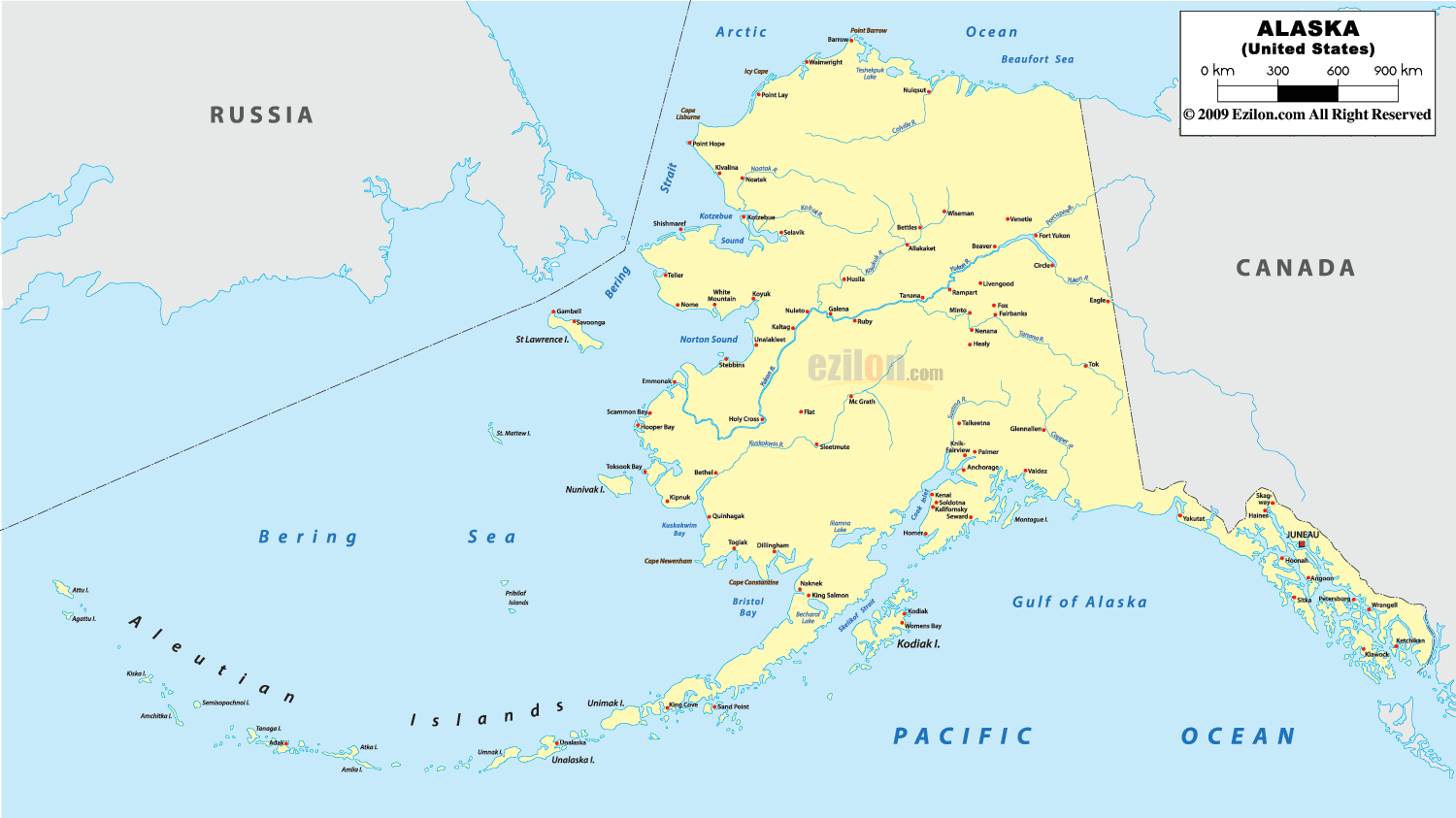
Alaska Lakes and Rivers Map
Alaska Physical Map
Alaska Topographic Map
Alaska Satellite Map
Others printable maps
Alaska Outline Map
Blank Alaska County Map
See also
Map of Alaska State and its subdivision:- Aleutians East
- Aleutians West
- Anchorage
- Bethel
- Bristol Bay
- Denali
- Dillingham
- Fairbanks North Star
- Haines
- Juneau
- Kenai Peninsula
- Ketchikan Gateway
- Kodiak Island
- Lake and Peninsula
- Matanuska-Susitna
- Nome
- North Slope
- Northwest Arctic
- Prince of Wales-Outer Ketchi
- Sitka
- Skagway-Yakutat-Angoon
- Southeast Fairbanks
- Valdez-Cordova
- Wade Hampton
- Wrangell-Petersburg
- Yukon-Koyukuk
- Alabama
- Alaska
- Arizona
- Arkansas
- California
- Colorado
- Connecticut
- Delaware
- District of Columbia
- Florida
- Georgia
- Hawaii
- Idaho
- Illinois
- Indiana
- Iowa
- Kansas
- Kentucky
- Louisiana
- Maine
- Maryland
- Massachusetts
- Michigan
- Minnesota
- Mississippi
- Missouri
- Montana
- Nebraska
- Nevada
- New Hampshire
- New Jersey
- New Mexico
- New York
- North Carolina
- North Dakota
- Ohio
- Oklahoma
- Oregon
- Pennsylvania
- Rhode Island
- South Carolina
- South Dakota
- Tennessee
- Texas
- Utah
- Vermont
- Virginia
- Washington
- West Virginia
- Wisconsin
- Wyoming
